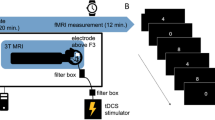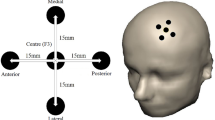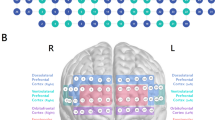Abstract
We studied brain changes during an N-back task before and after 10 sessions of transcranial direct current stimulation (tDCS) and its relation to cognitive changes. This was a double-blind, sham-controlled, randomized study of tDCS in 27 patients with schizophrenia. They performed an N-back task in a 3 T scanner before and after receiving the 10 tDCS sessions. Cognitive performance outside the fMRI session was assessed using the MATRICS Consensus Cognitive Battery and other tests at baseline and several time points after 10 sessions of tDCS. During the N-back task performed during fMRI scans, comparing the 0-back vs. the 2-back task, the active tDCS group demonstrated a significantly increased activation in the right fusiform, left middle frontal, left inferior frontal gyrus (opercular part) and right inferior frontal gyrus (triangular part) and reduced activation in the left posterior cingulum gyrus with most of these results primarily due to increases in activation during the 0-back rather than 2-back task. There were also significant positive or negative correlations between some of the brain changes and cognitive performance. tDCS modulated prefrontal activation at low working memory load or attention mode, but default mode network at higher working memory load. Changes in brain activation measured during the N-back task were correlated with some dimensions of cognitive function immediately after 10 tDCS sessions and at follow-up times. The results support tDCS could offer a potential novel approach for modulating cortical activity and its relation to cognitive function.



Similar content being viewed by others
Availability of data and materials
Not applicable.
References
Attwell, D., & Iadecola, C. (2002). The neural basis of functional brain imaging signals. Trends in Neurosciences, 25(12), 621–625. https://doi.org/10.1016/S0166-2236(02)02264-6
Baker, J. T., Holmes, A. J., Masters, G. A., Yeo, B. T. T., Krienen, F., Buckner, R. L., & Öngür, D. (2014). Disruption of cortical association networks in schizophrenia and psychotic bipolar disorder. JAMA Psychiatry, 71(2), 109–118. https://doi.org/10.1001/jamapsychiatry.2013.3469
Bestmann, S., & Walsh, V. (2017). Transcranial electrical stimulation. Current Biology : CB, 27(23), R1258–R1262. https://doi.org/10.1016/j.cub.2017.11.001
Callicott, J. H., Mattay, V. S., Verchinski, B. A., Marenco, S., Egan, M. F., & Weinberger, D. R. (2003). Complexity of prefrontal cortical dysfunction in schizophrenia: more than up or down. The American Journal of Psychiatry, 160(12), 2209–2215. https://doi.org/10.1176/appi.ajp.160.12.2209
Ciullo, V., Spalletta, G., Caltagirone, C., Banaj, N., Vecchio, D., Piras, F., & Piras, F. (2020). Transcranial direct current stimulation and cognition in neuropsychiatric disorders: Systematic review of the evidence and future directions. The Neuroscientist, 27(3), 285–309. https://doi.org/10.1177/1073858420936167
Cohen, J. D., Forman, S. D., Braver, T. S., Casey, B. J., Servan-Schreiber, D., & Noll, D. C. (1994). Activation of the prefrontal cortex in a nonspatial working memory task with functional MRI. Human Brain Mapping, 1(4), 293–304. https://doi.org/10.1002/hbm.460010407
Dong, L., Luo, C., Liu, X., Jiang, S., Li, F., Feng, H., Li, J., Gong, D., & Yao, D. (2018). Neuroscience information toolbox: An open source toolbox for EEG-fMRI multimodal fusion analysis. Frontiers in Neuroinformatics, 12, 56. https://doi.org/10.3389/fninf.2018.00056
Fan, F., Tan, S., Huang, J., Chen, S., Fan, H., Wang, Z., Li, C.-S. R., & Tan, Y. (2020). Functional disconnection between subsystems of the default mode network in schizophrenia. Psychological medicine, 1–11. https://doi.org/10.1017/S003329172000416X
Gronwall, D. M. (1977). Paced auditory serial-addition task: a measure of recovery from concussion. Perceptual and Motor Skills, 44(2), 367–373. https://doi.org/10.2466/pms.1977.44.2.367
Guse, B., Falkai, P., Gruber, O., Whalley, H., Gibson, L., Hasan, A., Obst, K., Dechent, P., McIntosh, A., Suchan, B., & Wobrock, T. (2013). The effect of long-term high frequency repetitive transcranial magnetic stimulation on working memory in schizophrenia and healthy controls–a randomized placebo-controlled, double-blind fMRI study. Behavioural Brain Research, 237, 300–307. https://doi.org/10.1016/j.bbr.2012.09.034
Hill, K., Mann, L., Laws, K. R., Stephenson, C. M. E., Nimmo-Smith, I., & McKenna, P. J. (2004). Hypofrontality in schizophrenia: a meta-analysis of functional imaging studies. Acta psychiatrica Scandinavica, 110(4), 243–256. https://pubmed.ncbi.nlm.nih.gov/15352925
Horan, W. P., Wynn, J. K., Mathis, I., Miller, G. A., & Green, M. F. (2014). Approach and withdrawal motivation in schizophrenia: An examination of frontal brain asymmetric activity. PLoS ONE, 9(10), e110007. https://doi.org/10.1371/journal.pone.0110007
Hoy, K. E., Arnold, S. L., Emonson, M. R. L., Daskalakis, Z. J., & Fitzgerald, P. B. (2014). An investigation into the effects of tDCS dose on cognitive performance over time in patients with schizophrenia. Schizophrenia research, 155(1–3). https://doi.org/10.1016/j.schres.2014.03.006
Jeon, D.-W., Jung, D.-U., Kim, S.-J., Shim, J.-C., Moon, J.-J., Seo, Y.-S., Jung, S.-S., Seo, B.-J., Kim, J.-E., Oh, M., & Kim, Y.-N. (2018). Adjunct transcranial direct current stimulation improves cognitive function in patients with schizophrenia: A double-blind 12-week study. Schizophrenia Research, 197, 378–385. https://doi.org/10.1016/j.schres.2017.12.009
Johnsen, L. K., Loren, V., van Themaat, A. H., Larsen, K. M., Burton, B. K., Baaré, W. F. C., Madsen, K. S., Nordentoft, M., Siebner, H. R., & Plessen, K. J. (2020). Alterations in task-related brain activation in children, adolescents and young adults at familial high-risk for schizophrenia or bipolar disorder - A systematic review. Frontiers in Psychiatry, 11, 632. https://doi.org/10.3389/fpsyt.2020.00632
Keefe, R. S. E. (2008). Should cognitive impairment be included in the diagnostic criteria for schizophrenia? World psychiatry : Official Journal of the World Psychiatric Association (WPA), 7(1), 22–28. https://doi.org/10.1002/j.2051-5545.2008.tb00142.x
Kronberg, G., Bridi, M., Abel, T., Bikson, M., & Parra, L. C. (2017). Direct current stimulation modulates LTP and LTD: Activity dependence and dendritic effects. Brain Stimulation, 10(1), 51–58. https://doi.org/10.1016/j.brs.2016.10.001
Li, X., Yi, Z.-H., Lv, Q.-Y., Chu, M.-Y., Hu, H.-X., Wang, J.-H., Zhang, J.-Y., Cheung, E. E. F., & Chan, R. C. K. (2019). Clinical utility of the dual n-back task in schizophrenia: A functional imaging approach. Psychiatry Research. Neuroimaging, 284, 37–44. https://doi.org/10.1016/j.pscychresns.2019.01.002
Lindenmayer, J. P., Kulsa, M. K. C., Sultana, T., Kaur, A., Yang, R., Ljuri, I., Parker, B., & Khan, A. (2019). Transcranial direct-current stimulation in ultra-treatment-resistant schizophrenia. Brain Stimulation, 12(1), 54–61. https://doi.org/10.1016/j.brs.2018.10.002
Liu, Y., Gu, N., Cao, X., Zhu, Y., Wang, J., Smith, R. C., & Li, C. (2021). Effects of transcranial electrical stimulation on working memory in patients with schizophrenia: A systematic review and meta-analysis. Psychiatry Research, 296, 113656. https://doi.org/10.1016/j.psychres.2020.113656
Minzenberg, M. J., Laird, A. R., Thelen, S., Carter, C. S., & Glahn, D. C. (2009). Meta-analysis of 41 functional neuroimaging studies of executive function in schizophrenia. Archives of General Psychiatry, 66(8), 811–822. https://doi.org/10.1001/archgenpsychiatry.2009.91
Narita, Z., Stickley, A., DeVylder, J., Yokoi, Y., Inagawa, T., Yamada, Y., Maruo, K., Koyanagi, A., Oh, H., Sawa, A., & Sumiyoshi, T. (2019). Effect of multi-session prefrontal transcranial direct current stimulation on cognition in schizophrenia: A systematic review and meta-analysis. Schizophrenia Research. https://doi.org/10.1016/j.schres.2019.11.011
Nuechterlein, K. H., Green, M. F., Kern, R. S., Baade, L. E., Barch, D. M., Cohen, J. D., Essock, S., Fenton, W. S., Frese, F. J., Gold, J. M., Goldberg, T., Heaton, R. K., Keefe, R. S. E., Kraemer, H., Mesholam-Gately, R., Seidman, L. J., Stover, E., Weinberger, D. R., Young, A. S., … Marder, S. R. (2008). The MATRICS Consensus Cognitive Battery, part 1: Test selection, reliability, and validity. The American Journal of Psychiatry, 165(2), 203–213. https://doi.org/10.1176/appi.ajp.2007.07010042
Nuechterlein, K. H., Barch, D. M., Gold, J. M., Goldberg, T. E., Green, M. F., & Heaton, R. K. (2004). Identification of separable cognitive factors in schizophrenia. Schizophrenia research, 72(1), 29–39. https://doi.org/10.1016/j.schres.2004.09.007
Orlov, N. D., O’Daly, O., Tracy, D. K., Daniju, Y., Hodsoll, J., Valdearenas, L., Rothwell, J., & Shergill, S. S. (2017). Stimulating thought: A functional MRI study of transcranial direct current stimulation in schizophrenia. Brain : a Journal of Neurology, 140(9), 2490–2497. https://doi.org/10.1093/brain/awx170
Palm, U., Keeser, D., Hasan, A., Kupka, M. J., Blautzik, J., Sarubin, N., Kaymakanova, F., Unger, I., Falkai, P., Meindl, T., Ertl-Wagner, B., & Padberg, F. (2016). Prefrontal transcranial direct current stimulation for treatment of schizophrenia with predominant negative symptoms: A double-blind, sham-controlled proof-of-concept study. Schizophrenia Bulletin, 42(5), 1253–1261. https://doi.org/10.1093/schbul/sbw041
Raichle, M. E. (2015). The brain’s default mode network. Annual Review of Neuroscience, 38, 433–447. https://doi.org/10.1146/annurev-neuro-071013-014030
Reichenberg, A., Caspi, A., Harrington, H., Houts, R., Keefe, R. S. E., Murray, R. M., Poulton, R., & Moffitt, T. E. (2010). Static and dynamic cognitive deficits in childhood preceding adult schizophrenia: A 30-year study. The American Journal of Psychiatry, 167(2), 160–169. https://doi.org/10.1176/appi.ajp.2009.09040574
Sheffield, J. M., & Barch, D. M. (2016). Cognition and resting-state functional connectivity in schizophrenia. Neuroscience and Biobehavioral Reviews, 61, 108–120. https://doi.org/10.1016/j.neubiorev.2015.12.007
Shi, C., Kang, L., Yao, S., Ma, Y., Li, T., Liang, Y., Cheng, Z., Xu, Y., Shi, J., Xu, X., Zhang, C., Franklin, D. R., Heaton, R. K., Jin, H., & Yu, X. (2015). The MATRICS Consensus Cognitive Battery (MCCB): Co-norming and standardization in China. Schizophrenia Research, 169(1–3), 109–115. https://doi.org/10.1016/j.schres.2015.09.003
Smith, R. C., Boules, S., Mattiuz, S., Youssef, M., Tobe, R. H., Sershen, H., Lajtha, A., Nolan, K., Amiaz, R., & Davis, J. M. (2015). Effects of transcranial direct current stimulation (tDCS) on cognition, symptoms, and smoking in schizophrenia: A randomized controlled study. Schizophrenia Research, 168(1–2), 260–266. https://doi.org/10.1016/j.schres.2015.06.011
Smith, R. C., Md, W. L., Wang, Y., Jiang, J., Wang, J., Szabo, V., Faull, R., Jin, H., Davis, J. M., & Li, C. (2020). Effects of transcranial direct current stimulation on cognition and symptoms in Chinese patients with schizophrenia✰. Psychiatry Research, 284, 112617. https://doi.org/10.1016/j.psychres.2019.112617
Uhlhaas, P. J., & Singer, W. (2012). Neuronal dynamics and neuropsychiatric disorders: Toward a translational paradigm for dysfunctional large-scale networks. Neuron, 75(6), 963–980. https://doi.org/10.1016/j.neuron.2012.09.004
Wang, H., Li, L., Wu, T., Hou, B., Wu, S., Qiu, Y., Feng, F., & Cui, L. (2016). Increased cerebellar activation after repetitive transcranial magnetic stimulation over the primary motor cortex in patients with multiple system atrophy. Annals of Translational Medicine, 4(6), 103. https://doi.org/10.21037/atm.2016.03.24
Weickert, T. W., Salimuddin, H., Lenroot, R. K., Bruggemann, J., Loo, C., Vercammen, A., Kindler, J., & Weickert, C. S. (2019). Preliminary findings of four-week, task-based anodal prefrontal cortex transcranial direct current stimulation transferring to other cognitive improvements in schizophrenia. Psychiatry Research, 280, 112487. https://doi.org/10.1016/j.psychres.2019.112487
Whitfield-Gabrieli, S., Thermenos, H. W., Milanovic, S., Tsuang, M. T., Faraone, S. V., McCarley, R. W., Shenton, M. E., Green, A. I., Nieto-Castanon, A., LaViolette, P., Wojcik, J., Gabrieli, J. D. E., & Seidman, L. J. (2009). Hyperactivity and hyperconnectivity of the default network in schizophrenia and in first-degree relatives of persons with schizophrenia. Proceedings of the National Academy of Sciences of the United States of America, 106(4), 1279–1284. https://doi.org/10.1073/pnas.0809141106
Wilk, C. M., Gold, J. M., McMahon, R. P., Humber, K., Iannone, V. N., & Buchanan, R. W. (2005). No, it is not possible to be schizophrenic yet neuropsychologically normal. Neuropsychology, 19(6), 778–786. https://doi.org/10.1037/0894-4105.19.6.778
Wu, D., & Jiang, T. (2020). Schizophrenia-related abnormalities in the triple network: A meta-analysis of working memory studies. Brain Imaging and Behavior, 14(4), 971–980. https://doi.org/10.1007/s11682-019-00071-1
Zhou, M., Zhuo, L., Ji, R., Gao, Y., Yao, H., Feng, R., Zhang, L., Huang, G., & Huang, X. (2021). Alterations in functional network centrality in first-episode drug-naïve adolescent-onset schizophrenia. Brain Imaging and Behavior. https://doi.org/10.1007/s11682-021-00505-9
Acknowledgements
We are thankful to our patients and patient’s family for their generous support, cooperation and participation. We appreciate very much the supporting from Professor John Marcell Davis (University of Illinois at Chicago) and Professor Hua Jin (University of California, San Diego).
Funding
This work was supported by the National Key R&D Program of China (2018YFC2001605); Shanghai Clinical Research Center for Mental Health (19MC1911100); Clinical Research Center at Shanghai Mental Health Center (CRC2018ZD01); Shanghai Municipal Science and Technology Major Project (2018SHZDZX03) and ZJLab; the SHSMU-ION Research Centre for Brain Disorders (2017NKX003); Science and Technology Commission of Shanghai Municipality (19411969400); the CAMS Innovation Fund for Medical Sciences (2019-I2M-5–039); Shanghai Intelligent Psychological Evaluation and Intervention Engineering Technology Research Center (20DZ2253800); the National Nature Science Foundation of China (61933003).
Author information
Authors and Affiliations
Contributions
CBL, RS and CL designed this study. WL, YRW and JLJ acquired the data. YL and HCL analyzed the data, assisted by XYC. YL, HCL and WL drafted the manuscript. THZ, YYT, DZY and JJW discussed the data. RS, CL and CBL reviewed the manuscript and all the authors approved the final version for submission.
Corresponding authors
Ethics declarations
Ethical approval
All procedures performed in studies involving human participants were in accordance with the ethical standards of the institutional and/or national research committee and with the 1964 Helsinki declaration and its later amendments or comparable ethical standards.
Consent to participate
Informed consent was obtained from all individual participants included in the study.
Consent to Publish
Not applicable.
Competing interests
None of the authors have a conflict of interest to declare.
Additional information
Publisher's note
Springer Nature remains neutral with regard to jurisdictional claims in published maps and institutional affiliations.
Supplementary Information
Below is the link to the electronic supplementary material.
Rights and permissions
About this article
Cite this article
Liu, Y., Li, H., Li, W. et al. Effects of transcranial direct current stimulation on brain changes and relation to cognition in patients with schizophrenia: a fMRI study. Brain Imaging and Behavior 16, 2061–2071 (2022). https://doi.org/10.1007/s11682-022-00676-z
Accepted:
Published:
Issue Date:
DOI: https://doi.org/10.1007/s11682-022-00676-z




